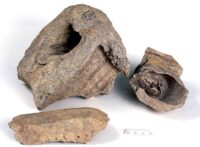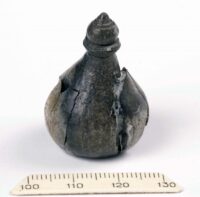 A group of nine mysterious bones unearthed in Kyiv years ago have been identified as walrus remains that originated in Greenland. The nine pieces of bone were excavated in 2007, 2008 and 2011 and were stratigraphically dated to the mid-12th century. It wasn’t immediately clear what animal they came from and researchers have only just determined that they were indeed walrus tusks.
A group of nine mysterious bones unearthed in Kyiv years ago have been identified as walrus remains that originated in Greenland. The nine pieces of bone were excavated in 2007, 2008 and 2011 and were stratigraphically dated to the mid-12th century. It wasn’t immediately clear what animal they came from and researchers have only just determined that they were indeed walrus tusks.
Samples were successfully extracted from seven of the nine bones and subjected to staple isotope and DNA analysis. Results found the ivory all came from the Atlantic walrus whose habitat ranged from Greenland to the Canadian Arctic. The evidence of human processing on the bones confirmed the western origin.
When the walrus tusks were exported, they were still attached to a piece of the snout bone. Remains of this bone are what the archaeologists found. Walruses have extremely strong muzzles, since they like to support their entire body weight on their tusks when they relax. In order to make it easy to break off the tusks, the muzzle was therefore “thinned” before export. This was done in a particular way in Greenland.
 Walrus ivory was a prized raw material in the Middle Ages, particularly in northern Europe. Elephant ivory was a luxury import and the disruption of ancient trade networks made locally-sourced walrus teeth even more valuable. Master carvers transformed walrus ivory into luxury game pieces like the Lewis Chessmen or masterpieces of religious art like the gilded and painted Crucified Christ.
Walrus ivory was a prized raw material in the Middle Ages, particularly in northern Europe. Elephant ivory was a luxury import and the disruption of ancient trade networks made locally-sourced walrus teeth even more valuable. Master carvers transformed walrus ivory into luxury game pieces like the Lewis Chessmen or masterpieces of religious art like the gilded and painted Crucified Christ.
Walrus hunting was immensely profitable. (A 14th century tax document records a single tusk was worth the equivalent of a year’s average income in Norway.) Indeed, it was such a cash cow that it was one of the main drivers for the Norse settlement of Iceland in the 9th century and, once they rapidly obliterated that population of walruses, the settlement of Greenland in the 10th century. Walrus remains are so widespread in the medieval archaeological layers of Greenland that the Norse settlers were all involved in the walrus ivory trade, either as hunting crews who spent three months of the year trawling the Arctic Sea for their quarry or in the extraction and processing of the tusks and teeth.
The ivory harvested in Iceland and Greenland was believed to have been sold in Western European markets whereas the medieval walrus ivory found in Eastern Europe was believed to have originated in Arctic Russia. The Kyiv ivories have proven that the eastern market for walrus products relied on Greenland’s hunting grounds as well.
Kyiv was a very important trading city in the Middle Ages, centrally located on the banks of Europe’s fourth longest river, the Dnipro, where traders from the north and south met.
“In the 12th century, Kyiv was a mediaeval metropolis and the capital of a state with an economy built on trade. Archaeological research shows that the largest amount of imported finds stem from the end of the 11th century and the 12th century,” says Khamaiko.
“What we’ve now discovered about the walrus bones shows that Kyiv was an unusually large trading centre, with goods flowing through from distant parts of the world.”
The research team’s report of the findings, the excellently named Walruses on the Dnieper, has been published in the Proceedings of the Royal Society B and can be read in its entirety here.

———
Aḥmad ibn Faḍlān ibn al-ʿAbbās ibn Rāšid ibn Ḥammād, c. 879–960) commonly known as Ahmad ibn Fadlan, was a 10th-century Arab Muslim traveler, famous for his account of his travels as a member of an embassy of the Abbasid caliph, al-Muqtadir of Baghdad, to the king of the Volga Bulgars, known as his risāla (“account” or “journal”).
His account is most notable for providing a detailed description of the Volga Vikings, including eyewitness accounts of life as part of a trade caravan and witnessing a ship burial.
Ibn Fadlan’s detailed writings have been cited by numerous historians. They have also inspired entertainment works, including Michael Crichton’s novel Eaters of the Dead and its film adaptation The 13th Warrior. According to Ahmad:
———
“The moment their boats reach this dock every one of them disembarks, carrying bread, meat, onions, milk and alcohol (nabīdh), and goes to a tall piece of wood set up . This piece of wood has a face like the face of a man and is surrounded by small figurines behind which are long pieces of wood set up in the ground. he reaches the large figure, he prostrates himself before it and says, “Lord, I have come from a distant land, bringing so many slave-girls such and such per head and so many sables such and such per pelt.” He continues until he has mentioned all of the merchandise he has brought with him, then says, “And I have brought this offering,” leaving what he has brought with him in front of the piece of wood, saying, “I wish you to provide me with a merchant who has many dīnārs and dirhams and who will buy from me whatever I want without haggling over the price I fix.” Then he departs. If he has difficulty in selling and he has to remain too many days, he returns with a second and third offering. If his wishes prove to be impossible he brings an offering to every single one of those figurines and seeks its intercession, saying, “These are the wives, daughters and sons of our Lord.” He goes up to each figurine in turn and questions it, begging its intercession and grovelling before it. Sometimes business is good and he makes a quick sell, at which point he will say, “My Lord has satisfied my request, so I am required to recompense him.” He procures a number of sheep or cows and slaughters them, donating a portion of the meat to charity and taking the rest and casting it before the large piece of wood and the small ones around it. He ties the heads of the cows or the sheep to that piece of wood set up in the ground. At night, the dogs come and eat it all, but the man who has done all this will say, “My Lord is pleased with me and has eaten my offering.”
—–
en.wikipedia.org/wiki/Ahmad_ibn_Fadlan
Second paragraph, line 3, “walrus which loved from Greenland”, should be “lived”.
Thank you, and to Amber, for providing this fascinating account of the lives of Viking Norsemen. Being able to connect with the humanity of ancient peoples is the link to bringing the artifacts to life.